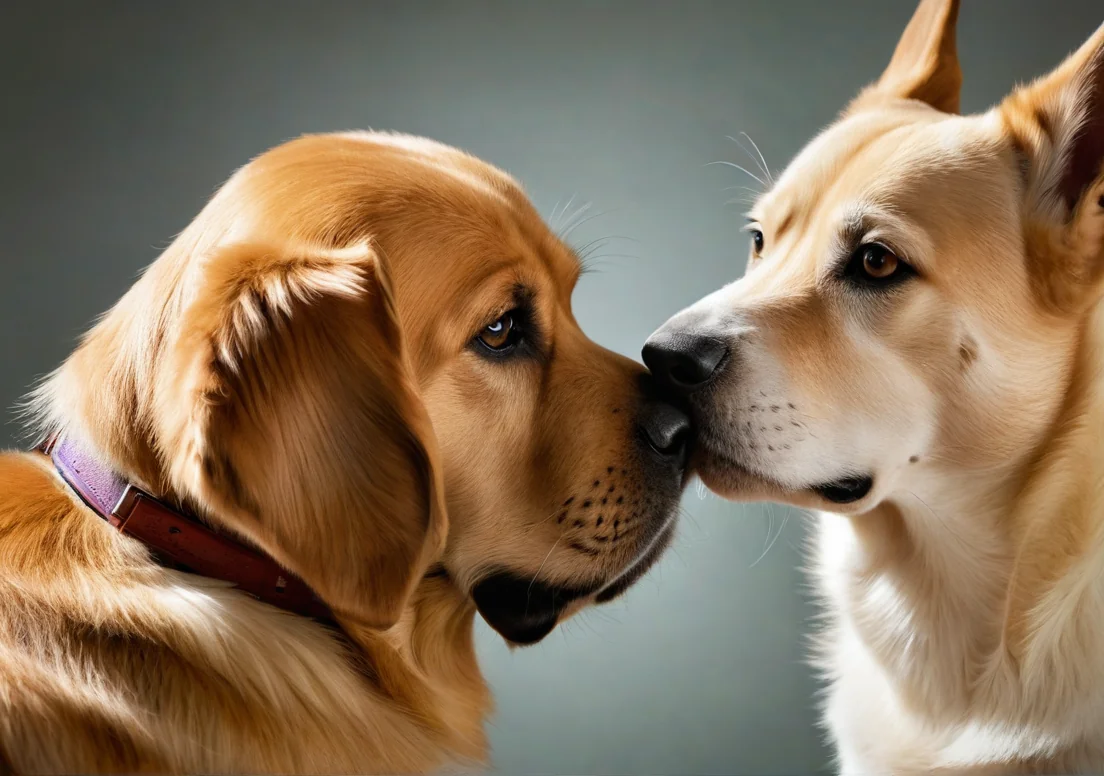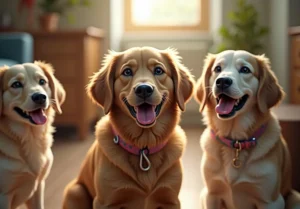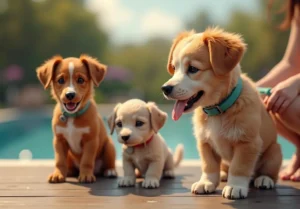Scent discrimination is an impressive skill that dogs naturally possess, and with the right training techniques, you can develop this ability to astonishing levels. Whether hunting, searching, or participating in competitions, teaching your dog to differentiate scents is not just fun—it’s essential.
To train your dog in scent discrimination, you’ll want to start with basic scent recognition exercises and progressively increase the complexity of the tasks. Focusing on positive reinforcement, consistency, and patience will help your dog master this magnificent skill. There’s so much more to uncover in the following sections that could change the way you train your furry friend—don’t miss out!

Start with Basic Scent Recognition
Building a solid foundation is key to successful scent discrimination training. Start by introducing your dog to a few distinct scents. It’s essential to use items that are easily identifiable and not overwhelming. For example, you might choose essential oils, spices, or even specific toys that carry a unique smell.
Begin with a simple game. Place a treat under one of several cups or containers, ensuring your dog has to use their nose to figure out which one hides the reward. This game helps them associate scents with rewards, reinforcing the idea that following their nose pays off.
Another handy technique is to create scent boxes. Use small boxes with different scented items — cotton balls soaked in various fragrances work well. Encourage your dog to sniff and differentiate between them. Over time, you can increase the complexity by introducing more scents and having your dog identify their favorites or specific targets. This gradual increase in difficulty helps reinforce their skills without overwhelming them.
As you train, observe your dog’s reactions closely. Praise them when they sniff out the right scent, as this will boost their confidence. Remember, the goal here is all about making it fun. The more playful and engaging you keep the training session, the better the outcomes will be.
Use Reward-Based Techniques
Positive reinforcement isn’t just a popular phrase; it’s a powerful method that can significantly enhance your dog’s learning during scent training. The best part? It’s simple and effective.
Start by rewarding your dog with treats, praise, or their favorite toy when they successfully identify a scent. This connection between the scent and positive feedback encourages them to engage more. Make sure to use high-value treats that will really grab their attention. Something irresistible can really spice up the training sessions!
Consider using a marker word or clicker when your dog successfully finds a scent. This lets them know exactly when they’ve done the right thing. You can reinforce this behavior by mixing up the rewards. Some days, use treats; other days, offer exciting playtime, or a favorite tug toy. This variation keeps them eager to participate.
It’s crucial to remain consistent with your cues and rewards. If your dog finds a scent and gets a different reaction than expected – say, praise one day and no reward the next – it can confuse them. This clarity in your responses helps build a stronger connection between the action and its consequence.
To further enhance the experience, vary the environments where you’re training. Scent work can happen anywhere, from your backyard to a park, or even indoors. Changing locations adds an element of excitement and helps your dog transfer their skills to different scenarios. This adaptability is vital as they begin to refine their scent discrimination abilities.
Gradually Increase Complexity
Training a dog’s scent discrimination skills is all about building layers. Start with basic exercises, letting your dog master the simple tasks before throwing in something more complex. This gradual increase in complexity can keep your dog engaged and turn training into a fun game rather than a chore.
For example, begin with familiar scents like a specific treat or your clothing. Once your dog can reliably identify these scents, introduce more challenging ones like oils or spices that are distinct yet similar. By doing this, you’re not just teaching your dog to find scents but also teaching them how to differentiate among them.
Focus on varied environments as you progress. Training in different locations can introduce distractions, making it harder for your dog. Allow them to adapt, reintroducing known scents in new settings. This approach helps your dog develop confidence and adaptability, key components for successful scent work.
One idea that can enhance this process is using reward variability. If your dog knows that every correct identification is met with praise and a treat, alternating rewards (like toys or affection) can increase their motivation and excitement towards each new challenge. This reinforces their learning and keeps the experience fresh.
Implement Scent Trails
Creating scent trails is an exciting way to engage your dog’s natural instincts. This practice, which involves laying down a path of scents for your dog to follow, not only sharpens their tracking abilities but also builds their confidence.
To start, you’ll want to pick a scent that your dog is familiar with. It could be a small piece of food, a toy, or even a scent sample you’ve acquired. Begin by laying out your trail in a straight line at first. Use a light touch—a few drops or crumbs spaced out to encourage sniffing rather than quickly bypassing it.
As your dog picks up on the trail, gradually increase the trail’s complexity. Add turns, obstacles, or different textures (like grass, gravel, and dirt), challenging your dog further as they improve. Make sure to reward them lavishly for successfully following the trail; this positive reinforcement builds enthusiasm and reinforces their learning.
Try using clouded trails sometimes, where you lay the scent down in a zig-zag pattern or mix in other scents to test their discrimination skills. This will not only enhance their sense of smell but also teach patience and problem-solving as they figure out which scent to follow.
Keep sessions short to maintain their interest, and don’t forget to take note of your dog’s progress. Tracking this can help you understand their strengths and areas where they might need a little more practice. Engaging in these scent trail exercises regularly can turn training into a bonding experience while also honing your dog’s natural talents.
Introduce Scent Discrimination Games
Engaging your dog in scent discrimination games can turn training into an enjoyable adventure for both of you. Start with simple activities that stimulate their natural sniffing instincts. One great game is the Doggy Hide and Seek: hide a favorite toy or treat and encourage your pup to find it using their nose. You can gradually increase the challenge by using different rooms or concealing the target in less obvious locations.
Another fun activity is the Scent Trail Game. Create a scent trail using a favorite treat or toy, and let your dog follow it to the source. This not only sharpens their ability to track scents but also strengthens your bond as they overcome the challenge. Don’t forget to mix it up! Use different scents like essential oils or spices to keep things interesting and broaden their scent recognition.
Quick Ideas for Fun Scent Games:
- Find It: Hide treats around the house for your dog to sniff out.
- Scent Basket: Fill a basket with various safe scent items for your dog to explore.
- Scent Matching: Use two identical containers with one containing a scented item and the other empty. Have your dog identify the right one!
Train in Varied Environments
Training your dog in varied environments is crucial for adaptability in real-world situations. Dogs don’t just learn in a controlled space like your home or yard; they absorb lessons from new sights, sounds, and smells. Start with familiar grounds, then gradually introduce new locations—like parks, busy streets, or even quiet nature trails.
Always observe how your dog reacts to these new stimuli. If they seem distracted, take a moment to sit and let them adjust before continuing with training. Consistency is key, but so is flexibility. Tailor your training sessions to the environment; for example, in a quiet park, you might focus on longer scent tasks, while in a bustling street, quick, responsive challenges can help keep their focus on you.
Moreover, don’t hesitate to introduce real-life scenarios. Setting scent challenges at places like pet stores or friends’ homes can further enhance their skills. Just make sure to keep it fun and rewarding; positive reinforcement is your best friend in these situations.
Combining engaging games with a variety of training environments will not only sharpen your dog’s scent discrimination skills but will also enrich their overall experience during training.
Leverage Natural Instincts
Dogs have a remarkable sense of smell, estimated to be about 10,000 to 100,000 times more acute than ours. This natural gift gives them a leg up in scent discrimination. To keep training engaging and effective, capitalize on this instinct.
Start by introducing scent games that mimic their natural hunting behavior. For instance, hide treats or toys with a strong scent around your home or yard. Encourage your dog to find them, allowing their nose to lead the way.
Additionally, use varied scents during training sessions. Incorporating scents beyond just food—like herbs, essential oils, or even different fabrics—can make it more interesting. Always reward your dog with praise or treats when they successfully identify a scent. This reinforces their natural abilities and builds their confidence in scent work.
Don’t overlook the power of socialization. Expose your dog to different environments and scents to enhance their learning. For instance, walks in parks, trips to pet-friendly stores, or visits to friends’ homes will expose your pup to a range of smells, making them even more adept at spotting and identifying scents during training.
Recent Studies on Canine Scent Discrimination
Research has expanded our understanding of canine scent discrimination capabilities. Recent studies have shown that dogs can distinguish between individual scents with impressive accuracy. For example, a 2023 study published in Frontiers in Veterinary Science revealed that dogs could differentiate between the scents of different cancer types in breath samples, showcasing their potential in medical detection roles.
The mechanisms behind this skill are mind-boggling. Dogs have more olfactory receptors—about 300 million compared to a human’s 6 million. This anatomical advantage, paired with their specialized brain structure dedicated to processing scents, allows them to detect minute differences in odor profiles.
To make the most of these findings, consider focusing training on less conventional scents. Get creative with your training sessions by incorporating items with distinct smells, like different spices or fruits.
Furthermore, engaging in research-backed training programs can help refine your dog’s abilities. Programs that emphasize scent mapping and scent tracking are particularly effective, teaching dogs to identify and follow specific scents over distances. This method builds their confidence and enhances their discriminative abilities, making them more capable in various scent-related tasks.
Unique Scent Training Tools
Scent discrimination training can hit the next level with the right tools. Think about specifics that can refine your approach and make those training sessions productive and fun. Here’s a breakdown of a few innovative tools that can help you and your dog dive into scent training.
Scent Discrimination Kits
– These kits often come with various scent containers and scented items. They allow you to familiarize your dog with different scents, which makes the process smoother. Choose kits that include natural scents, like herbs, and synthetic ones to provide variety.
Scented Puzzles
– Not just for fun, scented puzzles can stimulate your dog’s mind while enhancing their ability to differentiate scents. Look for puzzles specifically designed with scent training in mind. They have hidden compartments where you can place different scents for your dog to find.
Scent Markers
– These are really handy for marking training spaces. Use scent markers (like scented oils) to highlight areas where your dog should focus. This helps them associate specific scents with designated locations, boosting their learning speed.
Scent Discrimination Training Apps
– Technology can offer great support. Check out apps that provide training modules and tracking capabilities. They often provide step-by-step guidance, which can be super helpful for consistency and tracking progress.
Essential Oil Diffusers
– Get into the game with essential oils. A diffuser can spread specific scents throughout the training space, helping your dog learn to distinguish between them. Just be careful—some oils can be toxic to dogs, so stick to pet-safe options.
Portable Scent Logs
– These handy tools let you collect and carry various scents in an easy, organized way. You can use them for on-the-go training sessions without the hassle of transporting different items separately.
With these tools in your training arsenal, you’ll find the scent discrimination process not only more efficient but also a lot more engaging for your canine companion.
Alex, a passionate animal lover, has experience in training and understanding animal behavior. As a proud pet parent to two dogs and three cats, he founded AnimalReport.net to share insights from animal experts and expand his knowledge of the animal kingdom.




